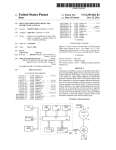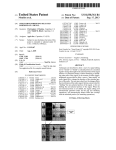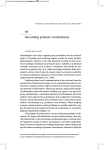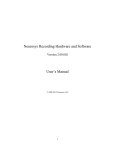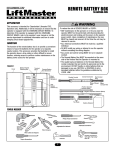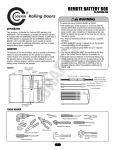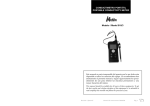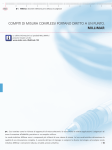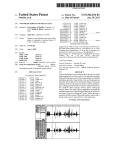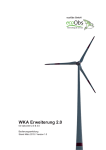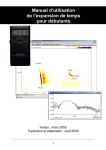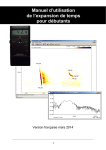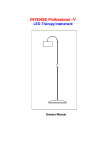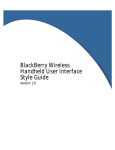Download Bat Detector Information Pack
Transcript
Bat Detector Information Pack The basics There are three types of bat detector: 1. Heterodyne Heterodyne detectors are tuneable – you select the frequency range to listen to. This makes them the best detectors for immediate identification of bats in the field. They work by filtering the inaudible bat sound with an ultrasonic signal from the detector, and producing the audible difference between the two sounds. Sounds can be recorded onto a recorder, but recordings cannot be used with sound analysis software to generate sonograms as frequency information is not retained. They are the cheapest of the detectors and are simple to use, making them ideal for beginners. 2. Frequency Division Frequency division detectors detect all frequencies so there is no need to tune into a specific frequency, and you don‟t miss any bats. They sample a set of incoming sound waves and take an average to divide the incoming frequency by a particular factor to give an audible output (e.g. 50kHz ÷ factor of 10 into 5kHz). Sounds can be recorded and used with sound analysis software but some information is lost. They are generally low to mid-price but cheaper versions tend not to retain amplitude information. 3. Time Expansion Like frequency division detectors, Time Expansion detectors detect all frequencies. They work by digitally recording a short snatch of sound (e.g. 1 second), then playing it back at a slower speed, resulting in the highest quality recording of all the detector types and retention of the most information. The disadvantage is that while the detector is playing back the slowed-down sounds, it becomes "deaf" to any bats flying past so continuous recording is not possible. Sounds can be recorded and used with sound analysis software. They enable a very detailed analysis of the sound and a clearer sonogram when compared to frequency division. They are the most expensive of the detectors. Additional note Some detectors feature more than one type of sound conversion, for example some frequency division detectors have a heterodyne mode as well, and some feature all three models of sound conversion. These detectors are the most expensive. There are a number of factors to consider when choosing a bat detector. These include: Price Microphone and frequency range: Microphones determine the sensitivity of the bat detector. Piezo – best at mid frequencies (~45kHz), Electret – lower frequencies (<30kHz), and Capitance – higher frequencies (>80kHz). You will still be able to detect other frequencies, but the distance you can detect them from will vary. Detectors with more than one microphone are best because they will be sensitive at more than one frequency (e.g. Pettersson D100 overleaf). All European species are detectable within the range 20-120kHz. Bandwidth: How many kHz either side of your tuned frequency you can hear calls on (heterodyne). A wider bandwidth reduces the chances of missing species you are not tuned into, while a narrower bandwidth makes it easier to discern the difference between bats calling at similar frequencies. Design: size, display (LED/LCD), controls on side or top (side-controls easier for single-handed operation) The following is a guide to some of the detectors that are available on the market at the present time, and their main features. It is not intended as a review, and prices should only be used as a guide. Heterodyne Bat Detectors (Summary, in price order) Model Approx cost £36 Microphone (type & no.) Unknown Freq. range Unknown Bandwidth Batteries Size (mm) Speaker 16kHz (± 8kHz) 1 x 9V (PP3) 145x80x34 Y Semafor UF-140 £45 Unknown 10-140kHz Unknown 1 x 9V (PP3) 145x60x45 Y Semafor UF-220 £55 Unknown 10-220kHz Unknown 1 x 9V (PP3) 145x60x45 Y Ciel CDB 105 R2 Mono £60 Electret (1) 18-120kHz 10kHz (± 5kHz) 1 x 9V (PP3) 140x64x31 Y Magenta Bat4 £60 Electret (1) 15-130kHz 9kHz (± 4kHz) 4 x AAA 145x80x34 Y Ciel CDB 103 R3 Stereo £90 Electret (2) 15-130kHz 10kHz (± 5kHz) 1 x 9V (PP3) 170x75x40 Y Magenta Bat5 £90 Electret (1) 10-130kHz 9kHz (± 4kHz) 4 x AAA 135x72x27 Y Ciel CDB 101 R3 Stereo £115 Electret (2) 15-130kHz 10kHz (± 5kHz) 1 x 9V (PP3) 170x75x40 N Mini-3 £145 Electret (1) 15-160kHz 8kHz (± 4kHz) 2 x AA 147x65x40 Y Batbox IIID £150 Electret (1) 19-125kHz 16kHz (± 8kHz) 1 x 9V (PP3) 125x69x32 Y Ciel CDP 102 R3 Professional Stereo £150 Electret (2) - external 15-130kHz 13kHz (± 6.5kHz) External 9-12V DC Source 125x75x40 N Pettersson D100 £185 Electret (1) & Piezo (2) 10-120kHz 8kHz (± 4kHz) 1 x 9V (PP3) 113x71x33 Y Pettersson D200 £225 Electret (1) 10-120kHz 8kHz (± 4kHz) 1 x 9V (PP3) 119x60x25 Y Magenta MkII Kit Design features/ other factors Requires soldering & electronics skills & the ability to understand circuit diagrams. Integrated LED torch. ( „BATZ‟ model also available-same spec. aimed at children) LED torch. Large frequency dial with top illumination. Side controls for singlehanded operation. Wrist strap. LED display. LCD display with backlighting. Inbuilt LED torch. Side controls for singlehanded operation. Wrist strap. LCD display. External speaker can be added. Large illuminated tuning dial. BBC Wildlife Magazine “Best buy”. 12.5mm digital LCD display with backlight. Side controls for singlehanded operation. Boxed (for mounting and long-term surveys). Stereo/dual option-can observe 2 frequencies at the same time. LCD display. Built in speaker. Backlit frequency control. Fully backlit LCD display. Side controls – easy to adjust. Broadband Bat Detectors Frequency Division Detectors (Summary, in price order) Model Approx cost Division Factor Microphone Freq. range Amplitude retaining Batteries Size (mm) Design features/ other factors 1 x 9V (PP3) 1 x 9V (PP3) 1 x 9V (PP3) 140x64x31 Built in speaker and LED torch. Non-tuneable. Small internal speaker Comes with BatScan sound analysis software. Very simple design & easy singlehanded operation. Inbuilt speaker. Single-hand operation. FREQUENCY DIVISION ONLY Ciel CDB 205 Mono Belfry Bat Detector Batbox Baton £60 10 Electret (1) 18-120kHz N £65 Unknown Unknown 25-100kHz N £70 10 Electret (1) 20-120kHz Y Anabat II & ZCAIM (phasing out) Anabat SD1 £400 4,8,16,32 Electret (1) 10-200kHz N/A 1 x 9V (PP3) Unknown £1400 8,16,32 Electret (1) 10-200kHz N/A 4 x AA (internal) or 12V (external) 159x90x45 LED indicator. Uses compact flash memory cards for data storage. GPS recorder can be connected. Real time clock. Programmable monitoring. Unknown 165x46x34 FREQUENCY DIVISION AND HETERODYNE Ciel CDB 305 R2 Dual £100 10 Electret (1) 18-120kHz Bandwidth: 10kHz (± 5kHz) 15-120kHz Bandwidth: 10kHz (± 5kHz) N 1 x 9V (PP3) 140x65x40 Built in speaker Ciel CDB 301 R3 Advanced £200 10 Electret (2) Y 1 x 9V (PP3) 170x75x35 Unknown (2) 15-130kHz Bandwidth: 10kHz (± 5kHz) Y 1 x 9V (PP3) Unknown Backlit LCD display. Separate microphones for each function. Commentary button enabling notetaking. Boxed (for mounting and long-term surveys). Ciel CDP 302 (Available from April 2009) Batbox Duet Price to be advised 10 £270 10 Electret (1) 17-125kHz bandwidth: 16kHz (± 8kHz) Y 1 x 9V (PP3) 125x69x32 Pettersson D230 £425 10 Electret (1) Y 1 x 9V (PP3) 119x60x25 £525 10,20,40 Unknown 10-120kHz Bandwidth: 8kHz (± 4kHz) 15-200kHz U30 Y 2 x AA 147x65x40 Large LED display and control for single-handed operation. Wrist strap. LCD Display. Comment switch. Miniature „ultralow-noise‟ microphone Time Expansion Detectors (Summary, in price order) Model Approx cost Expansion Factor Microphone Freq. range Batteries Size (mm) Design features/ other factors 145x95x45 Hands-free (worn around neck). No speaker. 4 x AA (& internal battery) 1 x 9V (PP3) 155x95x52 4 x AA 170x110x40 LED display. Internal digital recorder. 10.24sec memory. LCD Display. Comment switch. Storage time 3.4, 1.7 or 0.1sec. Automatic or manual trigger. 25.6sec memory. Voice commentary. Time tag30min intervals. Back-toback recording. TIME EXPANSION ONLY £470 Tranquility Transect N/A Capacitive 10-160kHz 4 x AA TIME EXPANSION AND HETERODYNE Tranquility III £750 10,32,64 Capacitive 12-160kHz Pettersson D240x £1100 10 Advanced Electret (1) 10-120kHz 8kHz (± 4kHz) ECO-Mega £1550 10,32,64 Capacitor 12-160kHz 119x60x25 Time Expansion, Frequency Division and Heterodyne Model Approx cost Frequency/ Expansion Factor Microphone Freq. range Batteries Size (mm) Design features/ other factors Batbox Griffin Price to be advised. Unknown Unknown Unknown AA Unknown Built in recording. Date, time, temperature & light reading levels. Programmable menudriven function set-up. £3800 From 1 (original speed) to 30 Capacitance (1) 10-200kHz Internal batteries or external power supply 6-10V 170x80x35 First bat detector with a built-in digital “tape recorder”. 16-bit recording system using compact flashcard as storage. Manuel or leveltriggering modes . Comments recording mode. (Launch date to be announced) Pettersson D1000x (built to order) Real-time Bat Recorders (for long-term, unattended monitoring) Model Approx cost Microphone Freq. range Batteries Size (mm) Design features/ other factors Pettersson D500x £1699 Electret (1) 4 x AA or external power supply 184x172x52 Detects and records ultrasound in real-time. Aimed for long-term unattended recording of bat calls. Four slots for CompactFlash memory cards with total capacity of 128GB. Triggering system allowing device to start recording as sound is detected. Batcorder €2400 Electret (1) N/A Sampling rates: 44.1kHz, 300kHz and 500kHz (optimised for 500kHz) 16-150kHz 4 x AA Unknown Analyses microphone signal in real-time and discriminates between bat calls and other sound signals. Autonomous long-term monitoring. Independent recording device and software built to cooperate with the hardware. (Email [email protected] for quote) Manufacturers and suppliers (details correct at time of going to print) Alana Ecology Ltd: www.alanaecology.com The Old Primary School, Church Street, Bishop's Castle, Shropshire, SY9 5AE. Tel: +44 (0)1588 630173. Email: [email protected]. Anabat SD1 Batbox: III-D, Baton, Duet, Griffin Magenta: MKII Kit, Bat4, Bat5 Mini-3 Pettersson D100, D200, D230, D240x, D500x, D1000x Batbox Ltd: www.batbox.com 2A Chanctonfold, Horsham Road, Steyning, West Sussex, BN44 3AA. Tel: 01903:816298. Email: [email protected]. Batbox III-D, Baton, Duet Bat Management: www.batmanagement.com US-based – email for a UK quote [email protected]. Pettersson D200, D500x (only available here), D1000x Bat Planet: www.batplanet.co.uk C/o Yarwood Ltd, Treefield Industrial Estate, Gelderd Road, Leeds LS27 7JU. Email [email protected] Full range of Ciel detectors (not including CDP 302) Belfry bat detector Bioquip: www.bioquip.net Batbox III-D and Duet Full range of Ciel detectors (not including CDP 302) Courtpan: http://courtpan.gnxt.net 3 Suffolk Street, Cheltenham, GL50 2DH. Tel: 01242 570123. Email [email protected]. Tranquillity Transect, Tranquility III, ECO-Mega EcoObs: www.ecoobs.com. Contact via online contact form http://www.ecoobs.com/cnt-contact.html Batcorder Green witch: www.green-witch.com (search for bat detectors) Tel: 01954 211 288 Batbox: III-D, Baton, Duet, Griffin (available to pre-order) Magenta Electronics Ltd: www.magenta2000.co.uk 135 Hunter Street, Burton on Trent, Staffs, DE14 2ST. Tel: 01283 565435. Email: [email protected]. Magenta: MKII Kit, Bat4, Bat5 Pettersson Elektronik AB: www.batsound.com Sweden-based – email for a UK quote [email protected] Full range of Pettersson detectors (except D500x) Semafor: http://www.semafor.co.uk/bat-detector.html Email: [email protected] (for a catalogue) Semafor UF-140, UF-220 (Please note that both models are currently marked as „unavailable‟ on their website.) Titley Electronics: www.titley.com.au Australia-based – can be shipped to UK. Email: [email protected]. Anabat II is being phased out, and Anabat SD1 is also available from UK suppliers Alana Ecology (details above). Anabat II, Anabat SD1 Ultra Sound Advice: http://www.ultrasoundadvice.co.uk 27 Merton Hall Road, Wimbledon, London SW19 3PR. Tel: 020 8287 4614. Email: [email protected]. Mini3 Detector, U30 Detector Sound Analysis Software A selection of software packages for analysing bat echolocation calls recorded using a broadband bat detector (time expansion or frequency division). Adobe Audition v 3.0. Is a substantial package that calculates all the start/end/peak frequencies of a pulse for you and you can do great manipulations with the sound. It can also convert batches of mp3 or other formats to WAV format really quickly. You can also listen to heterodyne separate from the FD channel on Duet recordings which is a good training tool. Audition is available as a 30 day try-out and the full package is $350. Web site http://www.adobe.com/uk/products/audition/ Avisoft at www.avisoft.com offers free download of a minimal program called SAS lab Light (5.7 MB) for very basic editing and generation of spectrograms. The full Avisoft has a whole range of functions although it takes time to learn how to use them all. Bat Scan available from www.batbox.com comes with a selection of sample files so that you can compare your own recordings. It costs £17 (plus VAT and delivery) and is a simplified version of Spectrogram. In general it is faster and easier to use than BatSound, but does not have all of the functions, although the sonogram is nice and clear and there are memory saving devices. Follow up service and advice is always outstanding. It is also available from Alana ecology www.alanaecology.com at £30 (including VAT). BatSound the original software developed especially for use with ultrasonic bat calls. It is available from Alana Ecology www.alanaecology.com and costs around £275 and more for multiple licenses. BatSound has a nice big window for sonograms and an easy to use toolbar with shortcut buttons that operate on a mouse click for common functions. It has lot of extra tools but also some annoying little quirks like re-setting your parameters as you are working. The help files are generally well structured and easy to use. You can download an evaluation version for free from the BatSound website at http://www.batsound.com/psonan.html (1210kb). Bat Wave Analyzer can be found by going to the Arboriculture Information Exchange site at http://www.aie.org.uk/ and look in the A-Z index for Bats. It has been developed by Chris Skillern and is available as a free download at the moment (you will need 364k). There is also a help manual to go with the program. It allows all the usual recording and analysis and notes can be inserted onto the sound wave and saved with the file. Totally free so well worth snapping it up while you can. bcAnalyze 1.0 is a programme designed to work with real-time recordings of bat calls. To be used with recordings from the batcorder system http://www.ecoobs.com/cnt-bcAnalyze.html. A call finding algorithm quickly finds calls within the recording. A license costs €140 (+VAT) and runs for 30 days in trial mode. System requirement is a Mac running Mac OS X 10.5. Cool Edit Pro 2.1 an old favourite taken over by Audition is now available as a free download from http://www.softpedia.com/progDownload/Cool-Edit-Pro-Download-2076.html (18.20 MB). It is not the full version but is still useful and recommended for people that want to have a try with a simple program. The spectrogram and oscillogram cannot be viewed simultaneously. The Bioacoustics Research Programme at Cornell Laboratory of Ornithology developed a well respected sound program called Canary some time ago. It is free to download, but unfortunately only runs on Mackintosh http://www.birds.cornell.edu/brp/software/canary-information. The user manual has some really useful background information about how spectrograms are created and analysed. If you are willing to delve into some physics it can help you to use other sound analysis programs more effectively. Relevant sections (available from http://www.birds.cornell.edu/brp/software) are Appendix A: Digital Representation of Sound, and Appendix B: A Biologists Introduction to Spectrum Analysis: The new sound analysis software from Cornell University, called ‘Raven’ is available from http://www.birds.cornell.edu/brp/raven/Raven.html. There are two options – Raven v 1.4, and Raven Lite which is free. Full version is able to display any number of sound files simultaneously, with each file in its own window. It has other features that allow you to easily measure, compare and edit parts of different sequences and sounds. The Raven Lite version has ability to view only a single spectrogram at one time. Both versions are available for Mac OSX or PC. The full version is US $400 ($100/year for students). Sonobat v 2.5.5 is a program developed in the USA. It includes an auto-trigger recording function developed especially for the D240x set up to trigger automatically & allowing remote recording to a digital recorder. It allows you to look at reference calls in the same window next to a call that you are trying to identify. Reference calls are automatically adjusted to match time and frequency scale of the one you are looking at. Analysis functions are plentiful including definition of low/high frequencies, bandwidth, duration, heel, slope, characteristic frequencies, harmonics and automatic calculation of the inter-pulse interval. The program costs US$320. There is a free downloadable demo of v2.4 for Mac and PC. www.sonobat.com. Sony Sound Forge available at http://www.sonycreativesoftware.com/products/soundforgefamily.asp. These are audio editing and production software. Sound Forge Audio studio costs £33.29 and there is a free trial available. Also available is Sound Forge 9 – Professional audio production suite, costing £230. Spectrogram v 16 processes both ultrasonic and audible sound. You have to select the ultrasound controls and it has a lot of functions that are not relevant for bat analysis. It can take a while to set up the parameters to your personal requirements although once done it is easy enough to use. The help file is huge but otherwise it is similar to BatScan. Most operations use function keys. It is free to download at http://www.visualizationsoftware.com/gram.html. Richard Horne who developed it is very helpful and any queries receive a quick response. Syrinx is another program designed by Dr John Burt for bird calls. It shows a spectrographic rolling display and allows analysis and editing. It can be obtained for free after filling in a short application form at http://syrinxpc.com. TF32 is a free programme which is very simple to use. There is a user manual available on the website http://www.medsch.wisc.edu/~milenkvc/tools.html. Wavesurfer – another completely free program available from http://www.speech.kth.se/wavesurfer. This was developed for speech analysis and you need to establish your own spectrogram parameters and save them so you need to know a little about the terminology (FFTs etc.) or you can look at the ibats website for instructions written by Dr Jon Russ http://www.ibats.org.uk/page.aspx?tabid=256 Web addresses frequently change. If the link no longer works enter the programme name in a search engine such as Yahoo or Google. Oct 2009 The Bat Conservation Trust, 15 Cloisters House, 8 Battersea Park Road, London SW8 4BG Tel: 0845 1300 228 Fax: 020 7627 2628 Email: [email protected] www.bats.org.uk








